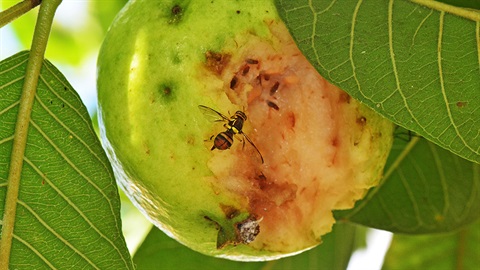Queensland fruit fly

Managing Queensland Fruit Fly is a community effort. Working together we can prevent it from becoming established in Darebin.
What is Queensland Fruit Fly?
Queensland Fruit Fly (QFF) is a serious horticultural pest that can devastate commercial and backyard fruit crops. It lays its eggs in many common fruits and vegetables, causing the flesh to rot and making it inedible.
Over time QFF have spread from their native habitat in Queensland rain forests to parts of Victoria. Sadly, small outbreaks have occurred in the inner Melbourne area, with recent sightings being reported in Darebin for the first time.
If you have fruit trees or fruiting vegetables in your garden, it's important to start preparing your garden for Queensland Fruit Fly.
How to identify Queensland Fruit Fly
Adult QFF are about 7mm long and reddish-brown in colour, with distinct yellow markings on the body and transparent wings. The larvae/maggots are white or cream and 2-9 mm long. They are wedge shaped and plumper at the tail end. A black feeding hook is visible in mature larvae. You can find between 2 and 20 larvae in infested fruit.
If you find Queensland Fruit Fly in your garden, it's quick and easy to report it online (1 min to complete):
Queensland fruit fly reporting
Common host fruit
QFF can infest nearly all common fruits and fruiting vegetables such as: stone fruit (such as nectarines, peaches, nectarines), pome fruit (apples, quinces, pears), citrus (lemons, limes, oranges, cumquats), tomatoes, berries, cherries and grapes.
For a comprehensive list, see Agriculture Victoria’s list of host fruits.
Life cycle
Watch Agriculture Victoria's video about the QFF life cycle to learn about its life cycle and how it spreads.
Managing Queensland Fruit Fly
Learn how to identify, prevent and manage QFF in your garden:
Darebin Backyard Harvest Series: Queensland Fruit Fly video
- Monitoring: Hang pheromone-based traps to monitor and catch fruit flies. These traps indicate if fruit flies are active in your area and when you need to act. You can also check fruit skin for small puncture marks.
- Baiting: Baits are made out of a protein bait attractant mixed with a small amount of a registered insecticide. The females eat the protein and are killed by the insecticide before egg laying occurs. They can be one of the most effective methods of fruit fly control but may not be suitable for organic gardening. If using, always follow label instructions.
- Exclusion: Net host fruit and vegetable plants with a fine UV stable mesh over a frame. Alternatively, you can place bags and sleeves over individual fruits.
- Pruning: Prune trees to a manageable height so fruit can be easily picked and netted. Remove fruit trees altogether if you don’t intend to harvest them, or contact the Darebin Fruit Squad to harvest your fruit trees for you, and contribute to local food relief efforts at the same time!
- Garden hygiene: Harvest produce as it ripens. Pick up and dispose of fallen fruit regularly.
- Correct disposal of fruit: If you find infested fruit, do NOT put in your compost bin or worm farm as this will aid the Queensland fruit fly life cycle. Process affected fruit by boiling, freezing or solarising (place in a plastic bag and leave in the sun for a week to kill larvae). Then dispose of in the landfill bin.
Baits, traps, nets, bags and sleeves can be purchased from nurseries and home garden retailers. You can try making your own baits and traps. Check out this guide on How to make DIY fruit fly traps by Gardening Australia.
Working together to stop the spread
Area-wide management is required for QFF control to be effective. In addition to protecting your own fruit and vegetables from being infested, it is everyone’s responsibility to reduce the spread of QFF to other areas.
- DO NOT dispose untreated produce directly into your rubbish or green bin, as it may spread to another area.
- DO NOT take infested fruit to another area – this is how it spreads easily
- Please DO help your neighbours to prune their trees
- Please DO carefully examine the fruit for pests and diseases before sharing and swapping fruit with friends
Resources
Learn how to identify, prevent and manage QFF in your garden:
Darebin Backyard Harvest Series: Queensland Fruit Fly video